This tutorial is a companion to the forehand loop against loop – side view tutorial, but showing a front view instead. Rather than repeat much of the side view version, I’ll just be pointing out items that are relevant to the front view.
Ready Position
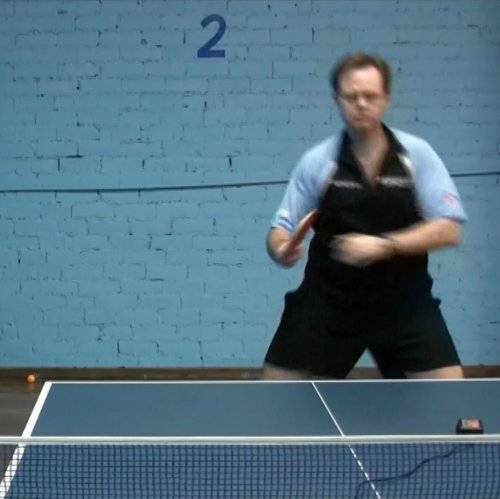
© Greg Letts
Points to look for:
- The player is in the middle of a forehand loop vs loop drill, and as such has modified his recovery a little, in order to better prepare for the next stroke. This is evident in the positioning of his free arm, and the slightly forehand grip angle.
- Even though he is in the middle of a drill and anticipating a ball to his forehand, the player has maintained good balance, allowing him to move in any direction quickly if necessary.
- This stroke is being played a little closer to the table than the side view sequence of photographs, since the robot being used was set to land the ball mid-court with heavy topspin rather than deep on the player’s side of the table.
Start Of Backswing
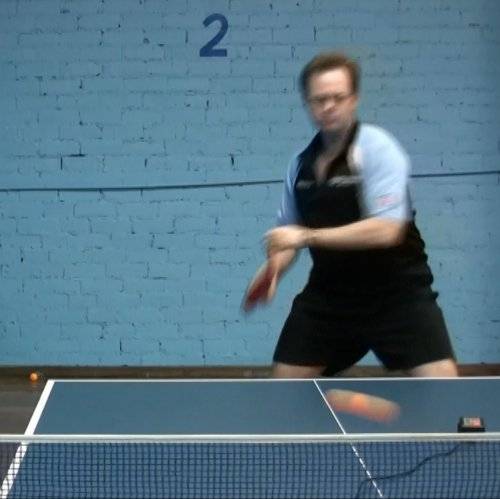
© Greg Letts
The ball is coming to the forehand side and the decision has been made to play a forehand loop. The backswing begins the stroke.
Points to look for:
- The player has put more of his body weight on his right foot, which will allow him to make a powerful shot by turning his body, without losing his balance.
- The hips, waist and shoulders have also turned to the right of the player, although the head is still facing forward watching the ball.
- The bat has moved backwards and downwards at this point. The amount that the bat moves backwards will vary from player to player, and will also be affected by the amount of power the stroke is hit with.
- Note that the bat has been brought back into position by the turning of the waist and shoulders, and by dropping the forearm a little. The bat is not moved into position by rotating the right arm around the shoulder joint.
End Of Backswing
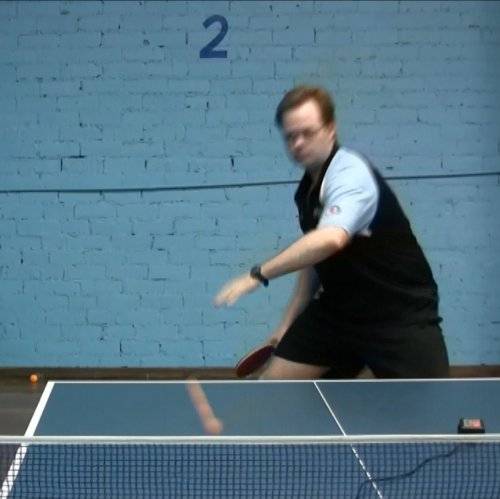
© Greg Letts
The backswing has finished, and the player is ready to begin his forward swing.
Points to look for:
- The player has continued to turn his waist and shoulders, and now the left shoulder is facing forward. Note that the waist and hips have not turned as far as the shoulders. This gives the player a stable base from which to unwind his body for extra power when swinging forward at the ball.
- The racket has been further lowered into position by dropping the forearm even more.
- The player has “set” his left leg by dipping a little with his left hip and leg. This braces the left side of the body for when the player begins to swing forward, allowing balance to be maintained more easily.
- From this perspective, it is clear that although much of the player’s bodyweight is on his right leg, his center of gravity is still between both legs, and he is by no means balancing only on his right leg.
Start Of Forward Swing
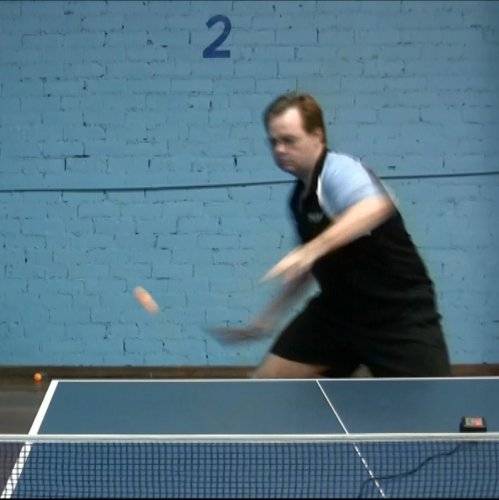
© Greg Letts
The ball has nearly reached the player, and the player has begun his forward swing.
Points to look for:
- The forward swing has begun with the player beginning to turn towards his left, as shown by the movement of the player’s free arm and left shoulder.
- The playing arm has been allowed to lag a fraction behind the turning of the body, which will allow the play to get extra power by whipping the playing arm back into synch with the body around the time of contact with the ball.
- Note that although the ball is clearly going to be quite a distance away from the player’s body, there is no need for the player to lean excessively onto his right leg. He has remained balanced, although much of his body weight is still on the right leg. This is accomplished by using a wide stance instead of a narrow shoulder width stance.
Pre-Contact With The Ball
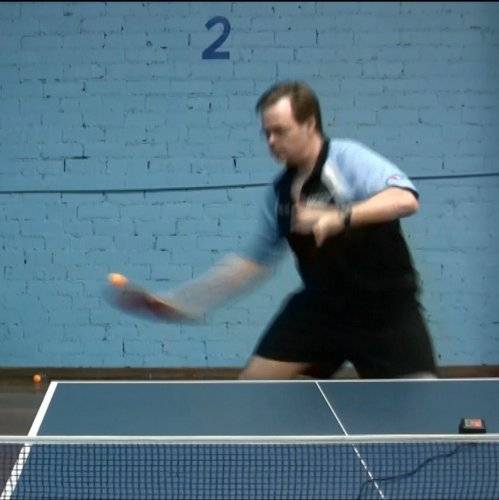
© Greg Letts
The player is about to make contact with the ball.
Points to look for:
- The player has continued to turn his body to his left, and is just now allowing his playing arm to catch up to the body turn, generating extra bat speed through contact.
- Contrast the blurring of the racket tip to the right forearm, right elbow, and right shoulder. The increase in blurring as you move down from the shoulder demonstrates clearly that the bat is being very quickly prior to contact, and the snapping of the forearm in a saluting motion is just beginning.
Contact With The Ball
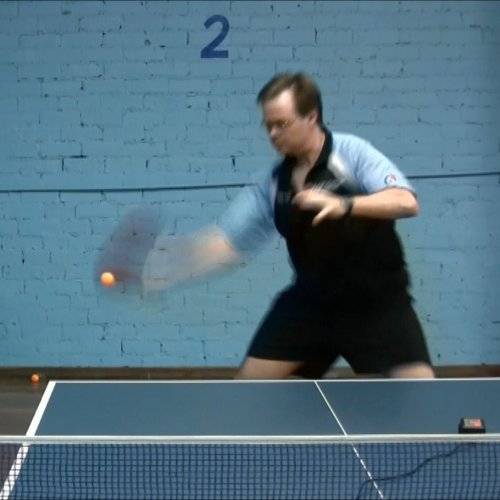
© Greg Letts
The player has made contact with the ball.
Points to look for:
- From this perspective, the high speed of the racket compared to the rest of the player’s arm is clear. The effect of the saluting motion is also shown clearly from this angle.
- The rest of the players body and left shoulder is comparatively still, since they have performed their task of beginning the swing and allowing the right arm to catch up in a whipping motion.
- Notice how still the player’s head has been throughout the stroke, even though the player has been moving and turning his body.
- This camera angle also shows quite clearly how far the right elbow is kept from the body during the forward swing. Some players will move the right elbow a few inches in either direction, but very few good players will keep the right elbow tucked in close to the body, since it hampers the forward swing.
- This particular player does not use a fully straightened right arm when hitting the ball. Some players like to have the arm fully straight whenever possible, but this does require very good footwork to perform successfully under pressure. Other players prefer to have more of a bend in the right arm. This tends to be a personal preference – you can find elite players that use fully straight arms, and those that have very bent arms, and everywhere in between. The player in the photograph prefers this arm angle, but will straighten or bend the arm a little for small adjustments that he does not have time to handle with his footwork.
Start Of Follow Through
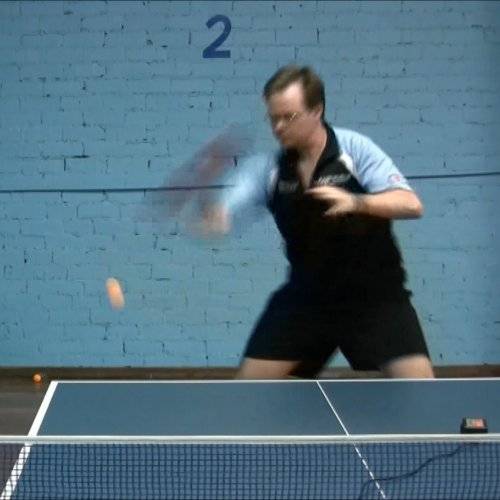
© Greg Letts
The ball is on its way over the net, and the player is starting his follow through.
Points to look for:
- The saluting motion is further demonstrated in this photograph.
- The upper body is beginning to level out, as the right side moves upwards throughout the follow through.
- The left leg is also pushing upwards, acting as a brace against the movement of the upper body, keeping the player balanced.
- The right arm has now caught back up to the turning of the body, but notice that it will not overshoot and move past this point, which would unbalance the player.
- It is worth noting that the player still looks very balanced, even in the midst of this powerful stroke.
End Of Follow Through
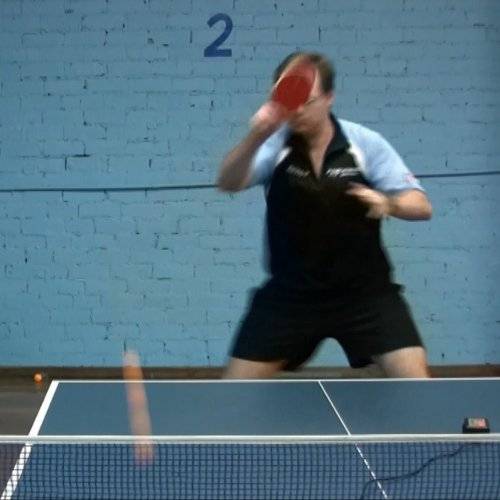
© Greg Letts
The forward swing has come to an end, and the ball is on its way over the net.
Points to look for:
- Note that despite the powerful swing made by the player, his right arm has not crossed over the center line of his body, and his right elbow has not moved past its starting position from a left/right point of view. The right elbow has finished higher than its original position, but not above shoulder level.
- The final saluting position is now clear, with the racket finishing in line with the player’s head, but well forward of it.
- The player is now almost back in balance, but with his center of gravity a little higher than his original starting position, due to the upwards nature of the swing. He will bring his center of gravity down as part of his recovery.
- From this finishing position, all the player needs to do is drop his racket arm back down as he lowers his body, and he will be in almost perfect position for his next stroke, whatever that may be. The use of correct technique and proper finishing position allows much faster recovery for the next stroke.
Start Of Return To Ready Position

© Greg Letts
The player is now recovering to the ready position for his next stroke.
Points to look for:
- The force of the swing has caused the player to continue to move his right hip and shoulder a little further to his left, as shown by the photograph. He has plenty of time to adjust his position back to a neutral ready position as his opponent plays the ball.
- The player’s arms are dropping back into their ready position.
- The player is beginning to lower his body and center of gravity back into the ideal ready position.
Return To Ready Position
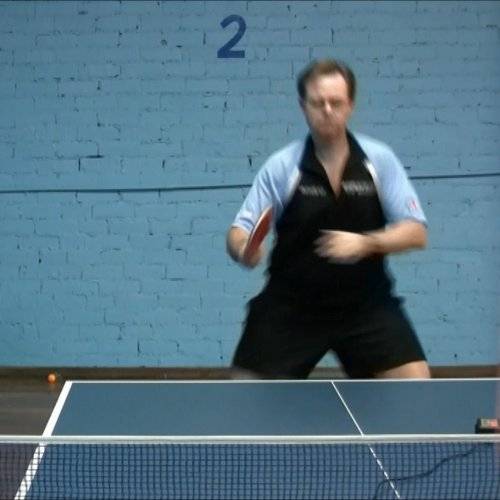
© Greg Letts
The player has returned to the ready position.
Points to look for:
- Since the last photograph, the player has now almost finished the process of lowering his center of gravity back to its original position, and has now turned back to his right a fraction to bring himself back into a truly neutral ready position.
- The arms have continued to drop towards their ready position. The bat is in a slight forehand position, since the player knows that the robot will be sending the next ball to his forehand.

